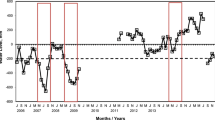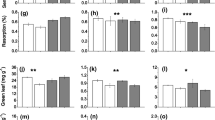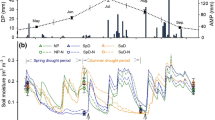Abstract
Biomass production, length of current-season shoots, number of new shoots produced per plant, reproductive effort, and tissue-nutrient concentrations of the ericaceous evergreenChamaedaphne calyculata (leatherleaf) were determined at two acidic peatland sites. Measurements were made under unfertilized conditions and following the addition of NPK over two conscutive years. The “shrub” site, a poor fen, had a deeper aerobic zone during most of the growing season, larger pools of N, P, K, Ca, and Mg within the surface peat (0–30 cm) and the leatherleaf biomass, and greater amounts of extractable P and K within the peat. At the poor fen, taller leatherleaf shrubs had significantly more biomass and longer shoots, and more flowers and fruits were produced. At the “open” site, a bog, leatherleaf plants doubled biomass productivity, shoot length, and allocation to reproductive structures, and increased the concentration of N, P, and K in current shoots in response to the additions of NPK. In contrast, leatherleaf at the poor fen site responded to the addition of NPK by only increasing the concentration of N, P, and K in the current shoots. These results suggest that the growth of leatherleaf may be limited by the availability of N, P, and/or K in bogs but not in poor fens.
Similar content being viewed by others
Literature Cited
Aerts, R. 1990. Nutrient use efficiency in evergeen and deciduous species from heathlands. Oecologia 84:391–397.
Aerts, R. and F. Berendse. 1988. The effect of increased nutrient availability on vegetation dynamics in wet heathlands. Vegetatic 76:63–69.
Aerts, R. and H. de Caluwe. 1989. Aboveground productivity and nutrient turnover ofMolinia caerulea along and experimental gradient of nutrient availability. Oikos 54:320–324.
Ali, M. W., S. C. Zoltai, and F. G. Radford. 1988. A comparison of dry and wet ashing methods for the elemental analysis of peat. Canadian Journal of Soil Science 68:443–447.
Allen, S. E., H. M. Grimshaw, and A. P. Rowland. 1986. Chemical Analyses. p. 285–344.In P. D. Moore and S. B. Chapman (eds.) Methods in Plant Ecology. Blackwell Scientific, Oxford, UK.
Andrus, R. E. 1980. Sphagnaceae (peat moss family) of New York State. New York State Museum Bulletin No. 442. The State Education Department Albany, NY, USA.
Armstrong, W. 1982. Waterlogged Soils. p. 290–330.In J. R. Etherington (ed.) Environment and Plant Ecology. John Wiley and Sons, London, UK.
Bartsch, I. 1991. Effects of Nutrient Addition on Growth and Nutrient Use by Leatherleaf andSphagnum spp. Ph.D. Dissertation. University of Maine, Orono, ME, USA.
Berendse, F., B. Beltman, R. Bobbink, R. Kwant, and M. Schmitz. 1987. Primary production and nutrient availability in wet heathland ecosystems. Acta Oecologia 8:265–279.
Bergersen, F. J. 1980. Measurement of nitrogen fixation by direct means. p. 65–110.In F. J. Bergersen (ed.) Methods for Evaluating Biological Nitrogen Fixation. John Wiley and Sons, Chichester, UK.
Bradbury, I. K. and J. Grace. 1983. Primary Production in Wetlands. p. 285–310.In A. J. P. Gore (ed.) Ecosystems of the World 4A, Mires: Swamp, Bog, Fen and Moor. Elsevier, Amsterdam, The Netherlands.
Brinson, M. M., A. E. Lugo, and S. Brown. 1981. Primary production, decomposition, and consumer activity in freshwater wetlands. Annual Review of Ecology and Systematics 12:123–161.
Cameron, C. C., M. K. Mullen, C. A. Lepage, and W. A. Anderson, 1980. Peat Resources of Maine, Volume 2: Penobscot County. Maine Geologic Survey Peat Publications, Bulletin 29. Augusta, ME, USA.
Chamie, J. P. M. and C. J. Richardson. 1978. Decomposition in Northern Wetlands. p. 115–130.In R. E. Good (ed.) Freshwater Wetlands. Academic Press, New York, NY, USA.
Chapin, F. S. 1988. Ecological aspects of plant mineral nutrition. Advances in Mineral Nutrition 3:161–191.
Chapin, F. S., W. C. Oechel, K. VanCleve, and W. Lawrence. 1987. The role of mosses in the phosphorus cycling of an Alaskan black spruce forest. Oecologia 74:310–315.
Chapin, F. S. and G. R. Shaver. 1989. Differences in growth and nutrient use among aretic growth forms. Functional Ecology 3:73–80.
Chapin, F.S., P.M. Vitousek, and K. van Cleve. 1986. The nature of nutrient limitation in plant communities. American Naturalist 127:48–58.
Clymo, R.S. 1963. Ion exchange inSphagnum and its relation to bog ecology. Annals of Botany 27:309–324.
Clymo, R. S. 1965. Experiments on the breakdown ofSphagnum. Journal of Ecology 53:747–758.
Damman, A. W. H. 1977. Geographical changes in the vegetation pattern of raised bogs in the Bay of Fundy region of Maine and New Brunswick. Vegetatio 35:137–151.
Damman, A. W. H. 1988. Regulation of nitrogen removal and retention inSphagnum bogs and other peatlands. Oikos 51:291–305.
Fernald, M. L. 1950. Gray’s Manual of Botany 8th Edition. American Book Co., New York, NY, USA.
Glaser, P. H., J. A. Janssens, and D. I. Siegel. 1990. The response of vegetation to chemical and hydrological gradients in the Lost River Peatland, northern Minnesota. Journal of Ecology 78:1021–1048.
Glaser, P. H., G. A. Wheeler, E. Gorham, and H. E. Wright. 1981. The patterned mires of the Red Lake Peatland northern Minnesota: Vegetation, water chemistry, and landforms. Journal of Ecology 69:575–599.
Goodman, G. T. and D. F. Perkins. 1968. The role of mineral nutrients inEriophorum communities. IV. Potassium supply as a limiting factor in anE. vaginatum community. Journal of Ecology 56:685–696.
Gore, A J. P. 1963. Factors limiting plant growth on high level peat. III. An analysis of growth ofMolinia caerula (L.) Moench. in the second year. Journal of Ecology 51:481–491.
Gorham, E., S. J. Eisenreich, J. Ford, and M. V. Santelmann. 1985. The chemistry of bog waters. p. 339–363.In W. Strumm (ed.) Chemical Processes in Lakes. John Wiley and Sons, Inc. New York, NY, USA.
Grime, J. P. 1977. Evidence for the coexistence of three primary strategies in plants and its relevance to ecological and evolutionary theory. American Naturalist 114:1169–1194.
Hayati, A. A. and M. C. F. Proctor. 1990. Plant distribution in relation to mineral nutrient availability and uptake on a wet heath site in southwest England. Journal of Ecology 78:134–151.
Hayati, A. A. and M. C. F. Proctor. 1991. Limiting nutrients in acid-mire vegetation: peat and plant analyses and experiments on plant responses to added nutrients. Journal of Ecology 79:75–95.
Hemond, H. 1983. The nitrogen budget of Thoreau’s Bog, Concord, Massachusetts, USA. Ecology 64:99–109.
Jacobson, G. L., Jr., L. Widoff, D. S. Anderson, and R. B. Davis. 1994. The vegetation of three Maine peatlands: Caribou Bog, Crystal Bog, and the Great Heath. Maine Geological Survey, Bulletin 35. Augusta, ME, USA.
Kenkel, N. C. 1987. Trends and interrelationships in boreal wetland vegetation. Canadian Journal of Botany 65:12–22.
Lieffers, V. J. and S. E. Macdonald. 1990. Growth and foliar nutrient status of black spruce and tamarack in relation to depth of water table in some Alberta peatlands. Canadian Journal of Forest Research 20:805–809.
Malmer, N. 1986. Vegetational gradients in relation to environmental conditions in northwestern European mires. Canadian Journal of Botany 64:375–383.
Malmer, N. and E. Holm. 1984. Variation in the C/N quotient of peat in relation to decomposition rate and age determination with210Pb. Oikos 43:171–182.
Moore, P. D. and D. J. Bellamy. 1974. Reatlands. Elek Science, London, UK.
Moore, T. R. 1989. Plant production, decomposition, and carbon efflux in a subarctic patterned fen. Arctic and Alpine Research 21: 156–162.
National Atmospheric Deposition Program. 1991. Annual Data Summary, Precipitation Chemistry in the United States, Greenville Station, ME, USA.
National Oceanic and Atmospheric Administration. 1990. Loca Climatological Data, NOAA National Climate Program Office, Asheville, NC, USA.
Neill, C. 1990. Effects of nutrients and water levels on species composition in prairie whitetop (Scolochloa festucacea) marshes. Canadian Journal of Botany 68:1015–1020.
Pastor, J., J. D. Aber, C. A. McClaugherty, and J. M. Melillo. 1984. Aboveground production and N and P cycling along a nitrogen mineralization gradient on Blackhawk Island, Wisconsin. Ecology 65:256–268.
Reader, R.J. 1982. Geographic variation in the shoot productivity of hog shrubs and some environmental correlates. Canadian Journal of Botany 60:340–348.
Rochefort, L., D. H. Vitt, and S. E. Bayley. 1990. Growth, production, and decomposition dynamics ofSphagnum under natural and experimentally acidified conditions. Ecology 71:1986–2000.
SAS. 1985. SAS User’s Guide: Statistics, Version 5 Edition. SAS Institute, Inc., Cary, NC, USA.
Schuster, R. M. 1974. The Hepaticae and Anthocerotae of North America. Columbia University Press, New York, NY, USA.
Schwintzer, C. R. 1981. Wegetation and nutrient status of northern Michigan bogs and conifer swamps with a comparison to fens. Canadian Journal of Botany 59:842–853.
Schwintzer, C. R. 1983. Primary productivity and nitrogen, carbon, and biomass distribution in a denseMyrica gale stand. Canadian Journal of Botany 61:2943–2948.
Schwintzer, C. R. and S. A. Lancelle. 1983. Effect of water table depth on shoot growth, root growth, and nodulation ofMyrica gale. Journal of Ecology 71:489–501.
Segadas-Vianna, F. 1955. Ecological study of the peat bogs of eastern North America. II. TheChamaedaphne calyculata community in Quebec and Ontario. Canadian Journal of Botany 33: 647–684.
Sheikh, K. H. 1969. The effects of competition and nutriton on the inter-relations of some weat-heath plants. Journal of Ecology 57:87–99.
Sjörs, H. 1950. On the relation between vegetation and electrolytes in North Swedish mire waters. Oikos 2:241–258.
Small, E. 1972. Photosynthetic rates in relation to nitrogen recycling as an adaptation to nutrient: deficiency in peat bog plants. Canadian Journal of Botany 50:2227–2233.
Summerfield, R. J. 1974. The reliability of mire water chemical analysis data as an index of plant nutrient availability. J. Plant and Soil 40:97–106.
Tamm, C. O. 1954. Some observations on the nutrient turnover in a bog community dominated byEriophorum vaginatum L. Oikos 5:189–194.
Tilton, D. 1978. Comparative growth and foliar clement concentrations ofLarix laricina over a range of wetland types in Minnesota. Journal of Ecology 66:499–512.
Vasander, H. 1982. Plant biomass and production in virgin, drained, and fertilized sites in a raised bog in southern Finland. Annales Botanici Fennici 19:103–125.
Verhoeven, J. T. A. and H. H. M. Arts. 1987. Nutrient dynamics in small mesotrophic fens surrounded by cultivated land. II. N and P accumulation in plant biomass in response to the release of inorganic N and P. Oecologia 72:557–561.
Verhoeven, J. T. A., E. Maltby, and M. B. Schmitz. 1990. Nitrogen and phosphorus mineralization in fens and bogs. Journal of Ecology 78:713–726.
Vitt, D. H. 1990. Growth and production dynamics of boreal mosses over climatic, chemical and topographic gradients. Botanical Journal of the Linnean Society 104:35–59.
Vitt, D. H. and S. Bayley. 1984. The vegetation and water chemistry of four oligotrophic basin mires in northwestern Ontario. Canadian Journal of Botany 62:1485–1500.
Whittaker, R. H. 1975. Communities and Ecosystems. Second Edition. MacMillan Publishing Co., New York, NY, USA.
Worley, I. A. 1981. Maine Peatlands: Their Abundance, Ecology, and Relevance to the Critical Areas Program. Maine State Planning Office, Critical Areas Program, Planning Report 73. Augusta, ME, USA.
Author information
Authors and Affiliations
Rights and permissions
About this article
Cite this article
Bartsch, I., Schwintzer, C. Growth ofChamaedaphne calyculata at two peatland sites in relation to nutrient availability. Wetlands 14, 147–158 (1994). https://doi.org/10.1007/BF03160630
Received:
Revised:
Accepted:
Issue Date:
DOI: https://doi.org/10.1007/BF03160630




